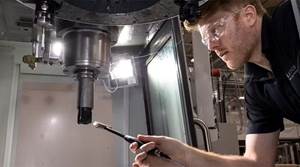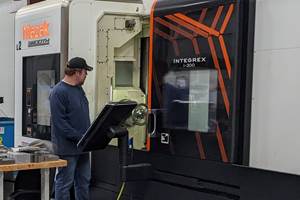Delivering Value Is Key
Machine data requires contextual interpretation to give decision makers a full understanding of what actions are best for optimizing shop floor results.
Share






How much value to business will data-driven manufacturing deliver in the near term? One research firm predicts that by 2020, the Industrial Internet of Things (IIoT) will impact nearly 6 percent of the global economy, with $1.9 trillion in productivity improvement and $177 billion in cost savings.
However, the capability of today’s advanced manufacturing equipment and the complexity of emerging processes bring challenges to successfully using data to cut costs and boost output. The current approach has some missing links. Capturing all relevant data is a problem. Adding contextual meaning to the data is an issue. Integrating shopfloor data with company business systems needs attention, too. Here is how to fix these roadblocks:
We need to expand connectivity. The good news is that using MTConnect to collect standardized data from controllers and sensors has become a reality. The not-so-good news is that we cannot capture data from all manufacturing equipment. Connectivity to legacy machines, the latest multi-path CNCs, robots, conveyors and new additive technologies is yet to be firmly established. Likewise, the variety of data sources, formats and complex data relationships exceed the capabilities of many existing solutions, almost all of which rely on basic machine states and alarms. This means that only about 10 percent of the data available from MTConnect is being used.
The focus must shift to expanding connectivity with diverse types of machines and using the full capabilities of MTConnect. This standard can help capture data about part inspection, tooling, speeds, feeds, and sensor output, for example. Using this range of data provides more than a view of greenlight time for each machine. In fact, it can discern that the spindle must be rotating at more than 100 rpm and that the load must be more than 10 percent to indicate that the machine is making chips.
We need to analyze data for context. Another missing link is using analytics to add context relating to the manufacturing process. We need a better understanding of what the data means. For example, the context provided by MTConnect is not sufficient to verify that the machine is operating correctly or to identify who is operating it. For this, the shop needs a way to associate the machine data with facts about the process. Knowing what is happening must converge with knowing that the right things are happening.
This data enrichment increases the value of the data by introducing judgement so that production leaders can act. For example, if spindle load during an operation is zero when it should be 20 percent, the tool is broken or missing. If no one catches this problem immediately, bad parts will result. Leveraging enriched data in analytics takes us beyond overall equipment efficiency ratings, monitoring and reporting. This step is core to sound, real-time decisions.
We need integration to derive business benefits. Integration of all context-rich information across the enterprise is the final missing link. Systems such as CAD/CAM, manufacturing execution, enterprise resource planning and product lifecycle management must learn from and respond to production results. Unfortunately, these systems were not designed to use data from manufacturing equipment. Enrichment enables these applications to interpret the data for tasks and computations specific to their purpose. Machine data can then be integrated with job tracking, maintenance and supply chain management to enable end-to-end process automation and build continuous feedback loops for process improvement.
We need a predictive, prescriptive future. With enhanced data acquisition, enrichment and integration, manufacturers can confidently connect all the pieces to derive value from shopfloor data. Fortunately, today there are next-generation solutions for machine analytics that offer expanded device connectivity and fully utilized MTConnect, enrichment that combines machine and process data for expert responses to actionable information and integration to nearly any enterprise system.
Manufacturers who embrace these solutions can expect substantial gains in the bottom line. Experience shows that increasing plant efficiency by only 15 percent can increase profits by a full 1 percent. More importantly, this achievement sets the stage for predictive and prescriptive analytics, which accurately tell not only what is going to happen, but also what is the best thing to do about it. The ultimate goal is to have sure-fire processes on bullet-proof equipment.
Related Content
How to Mitigate Chatter to Boost Machining Rates
There are usually better solutions to chatter than just reducing the feed rate. Through vibration analysis, the chatter problem can be solved, enabling much higher metal removal rates, better quality and longer tool life.
Read MoreContinuous Improvement and New Functionality Are the Name of the Game
Mastercam 2025 incorporates big advancements and small — all based on customer feedback and the company’s commitment to keeping its signature product best in class.
Read More5 Tips for Running a Profitable Aerospace Shop
Aerospace machining is a demanding and competitive sector of manufacturing, but this shop demonstrates five ways to find aerospace success.
Read MoreCan AI Replace Programmers? Writers Face a Similar Question
The answer is the same in both cases. Artificial intelligence performs sophisticated tasks, but falls short of delivering on the fullness of what the work entails.
Read MoreRead Next
Last Chance! 2025 Top Shops Benchmarking Survey Still Open Through April 30
Don’t miss out! 91ÊÓƵÍøÕ¾ÎÛ's Top Shops Benchmarking Survey is still open — but not for long. This is your last chance to a receive free, customized benchmarking report that includes actionable feedback across several shopfloor and business metrics.
Read MoreAMRs Are Moving Into Manufacturing: Considerations for Implementation
AMRs can provide a flexible, easy-to-use automation platform so long as manufacturers choose a suitable task and prepare their facilities.
Read MoreMachine Shop MBA
Making Chips and 91ÊÓƵÍøÕ¾ÎÛ are teaming up for a new podcast series called Machine Shop MBA—designed to help manufacturers measure their success against the industry’s best. Through the lens of the Top Shops benchmarking program, the series explores the KPIs that set high-performing shops apart, from machine utilization and first-pass yield to employee engagement and revenue per employee.
Read More


















